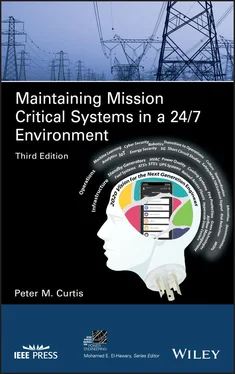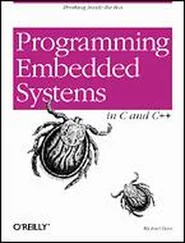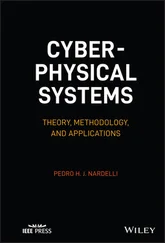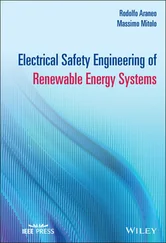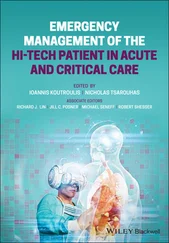1 Cover
2 Title Page
3 Copyright Page
4 Foreword
5 Preface
6 Acknowledgements
7 1 An Overview of Reliability and Resiliency in Today’s Mission Critical Environment 1.1 Introduction 1.2 Risk Assessment 1.3 Capital Costs versus Operation Costs 1.4 Critical Environment Workflow and Change Management 1.5 Testing and Commissioning 1.6 Documentation and Human Factor 1.7 Education and Training 1.8 Corporate Knowledge Transfer – the Means to Securing Tomorrow’s Critical Infrastructure 1.9 Operation and Maintenance 1.10 Employee Certification 1.11 Standards and Benchmarking 1.12 What is a Mission Critical Engineer 1.13 Conclusion 1.14 An Overview of Reliability and Resiliency in Today’s Mission Critical Environment ‐Questions to Consider
8 2 Energy and Cyber Security and its Effect on Business Resiliency 2.1 Introduction 2.2 Risks Related to Information Security 2.3 Electro Magnetic Pulse and Solar Flares 2.4 How Risks Are Addressed 2.5 Use of Distributed Energy Resources and Generation 2.6 Documentation and Its Relation to Information Security 2.7 Smart Grid 2.8 Conclusion 2.9 Energy Security and Its Effect on Business Resiliency ‐ Questions to Consider
9 3 Mission Critical Engineering with an Overview of Green Technologies 3.1 Introduction 3.2 Companies’ Expectations: Risk Tolerance and Reliability 3.3 Identifying the Appropriate Redundancy in a Mission Critical Facility 3.4 Improving Reliability, Maintainability, and Proactive Preventative Maintenance 3.5 The Mission Critical Facilities Manager and the Importance of the Boardroom 3.6 Quantifying Reliability and Availability 3.7 Design Considerations for the Mission Critical Data Center 3.8 The Evolution of Mission Critical Facility Design 3.9 Human Factors and the Commissioning Process 3.10 Short Circuit & Coordination Studies 3.11 Introduction to Direct Current in the Data Center 3.12 Containerized Systems Overview 3.13 Mission Critical Engineering with an Overview of Green Technologies ‐ Questions to Consider
10 4 Mission Critical Electrical System Maintenance & Safety 4.1 Introduction 4.2 The History of the Maintenance Supervisor and the Evolution of the Mission Critical Facilities Engineer 4.3 Internal Building Deficiencies and Analysis 4.4 Evaluating Your System 4.5 Choosing a Maintenance Approach 4.6 Safe Electrical Maintenance 4.7 Maintenance of Typical Electrical Distribution Equipment 4.8 Being Proactive in Evaluating the Test Reports 4.9 Designing for Safety and Reliability 4.10 Conclusion
11 5 Standby Generators 5.1 Introduction 5.2 The Necessity for Standby Power 5.3 Emergency, Legally Required, and Optional Systems 5.4 Standby Systems That Are Legally Required 5.5 Optional Standby Systems 5.6 Understanding Your Power Requirements 5.7 Management Commitment and Training 5.8 Standby Generator Systems Maintenance Procedures 5.9 Documentation Plan 5.10 Emergency Procedures 5.11 Cold Start 5.12 Non‐Linear Load Concerns 5.13 Conclusion
12 6 Fuel Systems Design and Maintenance 6.1 Introduction 6.2 Brief Discussion on Diesel Engines 6.3 Bulk Storage Tank Selection 6.4 Codes and Standards 6.5 Recommended Practices for all Tanks 6.6 Fuel Distribution System Configuration 6.7 Day Tank Control System 6.8 Diesel Fuel and a Fuel Quality Assurance Program 6.9 Conclusion
13 7 Power Transfer Switch Technology, Applications, and Maintenance 7.1 Introduction 7.2 Transfer Switch Technology and Applications 7.3 Types of Power Transfer Switches 7.4 Control Devices 7.5 Design Features 7.6 Additional Characteristics and Ratings of ATS 7.7 Installation & Commissioning, Maintenance, and Safety 7.8 General Recommendations 7.9 Conclusion
14 8 The Static Transfer Switch 8.1 Introduction 8.2 Overview 8.3 Typical Static Switch One Line 8.4 STS Technology and Application 8.5 Testing 8.6 Conclusion
15 9 The Fundamentals of Power Quality 9.1 Introduction 9.2 Electricity Basics 9.3 Transmission of Power 9.4 Understanding Power Problems 9.5 Tolerances of Critical Loads 9.6 Power Monitoring 9.7 The Impact of Alternative Energy Generation 9.8 Conclusion
16 10 UPS Systems: Applications and Maintenance with an Overview of Green Technologies 10.1 Introduction 10.2 Purpose of UPS Systems 10.3 General Description of UPS Systems 10.4 Components of a Static UPS System 10.5 Online ‐ Line Interactive UPS Systems 10.6 Offline (Standby) 10.7 The Evolution of Static UPS Technology 10.8 Rotary UPS Systems 10.9 Redundancy, Configurations, and Topology 10.10 Energy Storage Devices 10.11 UPS Maintenance & Testing 10.12 Static UPS and Maintenance10.13 UPS Management 10.14 Conclusion
17 11 Data Center Cooling Systems 11.1 Introduction 11.2 Background Information 11.3 Cooling within Datacom Rooms 11.4 Cooling Process 11.5 Cooling Final Dissipation 11.6 The Refrigeration Process 11.7 Components Inside Datacom Room 11.8 Conclusion
18 12 Data Center Cooling Efficiency, Concepts, & Technologies 12.1 Introduction 12.2 Heat Transfer Inside Data Centers 12.3 Cooling and Other Airflow Topics 12.4 Design Approaches for Data Center Cooling 12.5 Additional Considerations 12.6 Hardware & Associated Efficiencies 12.7 Best Practices 12.8 Efficiency Problem Solving 12.9 Conclusion 12.10 Conversions, Formulas, Guidelines
19 13 Raised Access Floors 13.1 Introduction 13.2 Design Considerations 13.3 Safety Concerns 13.4 Panel Cutting (For all Steel Panels or Cement Filled Panels that do not Contain an Aggregate) 13.5 Access Floor Maintenance 13.6 Troubleshooting 13.7 Additional Design Considerations 13.8 Conclusion
20 Chapter 14: Fire Protection in Mission Critical Infrastructures 14.1 Introduction 14.2 Hazard Analysis 14.3 Alarm and Notification 14.4 Early Warning Detection 14.5 Fire Suppression 14.6 Systems Design 14.7 Fire Detection 14.8 Fire Suppression Systems 14.9 Conclusion
21 Chapter 15: Managing Through Pandemics 15.1 Executive Summary: COVID‐19’s Impact on Critical Infrastructure Globally 15.2 Architectural Solutions and Air Purification Systems 15.3 Building Equipment Solutions and Technology 15.4 Operations, Maintenance and Training 15.5 Site Protection: Safeguarding the Staff and Visitors 15.6 The Workforce of Tomorrow 15.7 Assessment Tasks ‐ HVAC and Air Handling Units Filter Upgrades 15.8 Managing Through Pandemics ‐Questions to Consider 15.9 Conclusion
22 Appendix A: Policies and RegulationsA.1 Introduction A.2 Industry Policies & Regulations A.3 Data Protection A.4 Encryption A.5 Business Continuity Plan (BCP) A.6 Conclusion
23 Appendix B: Consolidated List of Key Questions
24 Appendix C: Airflow Management (A System Approach)C.1 Introduction C.2 Control is the Key C.3 Obtaining Control C.4 Air Management Technologies C.5 Conclusion
25 Glossary
26 References
27 Index
28 Books in the IEEE Press Series on Power Engineering
29 End User License Agreement
1 Chapter 1 Table 1.1 Levels of Risk Impact to Facilities Table 1.2 Critical Areas Table 1.3 Critical Systems Table 1.4 Managing Loss of Critical Personnel Table 1.5 Documentation Issues Table 1.6 Managing During Critical Events
2 Chapter 2 Table 2.1 Recent Significant Power Outages (Various Sources – Google Alert – M ... Table 2.2 Major Solar Flare Events
3 Chapter 3 Table 3.1 Law of Nines Table 3.2 The Cost of Downtime Table 3.3 Uptime Tiers
4 Chapter 4Table 4.1 Types of Personal ProtectionTable 4.2 Typical Personal Protective Equipment ExamplesTable 4.3 Glove and Boot Classification and the Corresponding Voltage.Table 4.4 Equipment Testing
5 Chapter 9Table 9.1 Causes and effects of power problemsTable 9.2 The frequency and phase sequence of whole number harmonics.Table 9.3 Power line disturbances and characteristics
6 Chapter 10Table 10.1 Bandgap Energy LevelsTable 10.2 SiC UPS Heat Loss Energy Savings (@500KVA)Table 10.3 Advantages and Limitations of Lead‐acid BatteriesTable 10.4 Advantages and Disadvantages of a FlywheelTable 10.5 Procedures and details used for a semi‐annual checks and services for...
Читать дальше
